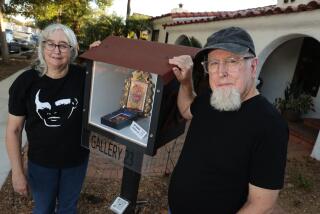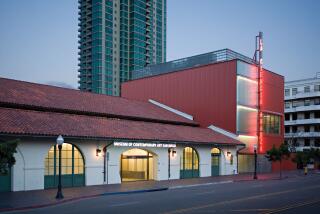Turning an artist’s dream into ‘Probabilities’
Now in its eighth week at the Municipal Art Gallery in Barnsdall Art Park, George Stone’s mind-bending exhibition of kinetic sculpture has been praised by critics and embraced by visitors who watch shadowy shapes morph from people to animals and observe heat-sensitive tree branches blossom into umbrellas. But no group is happier to see the show up and running than the Fellows of Contemporary Art, the local nonprofit organization that initiated it and provided the seed money.
“George Stone: Probabilities -- A Midcareer Survey” is only the latest of 33 contemporary art shows sponsored by the Fellows in the last 27 years, but it was a special challenge. The group approved Carole Ann Klonarides’ proposal for the exhibition in late 1998. She was a curator at the Santa Monica Museum of Art and planned to present the show there in early 2001, but the museum changed directors, she left her job and another venue had to be found.
The Municipal Art Gallery agreed to host the show, but it was closed for renovations in the surrounding park and buildings. The job hit one snag after another, keeping the city-owned gallery shuttered for three years. Stone’s work went on view Sept. 9, 2 1/2 years later than planned.
“My show dragged on and on for all kinds of reasons,” Stone says. “But the Fellows were steadfast. There was never a time when I thought they were going to pull out.”
Attorney Maureen Carlson, a 25-year Fellows member who guided the show through byzantine channels of the three city departments that govern the park, called the process “grueling but exciting.” “No group will survive unless it figures out how to meet its challenges,” Carlson says. And in these days of diminishing funds for the arts, that means working more collaboratively. “It takes a lot of players and it’s complicated,” she says, “but it’s all for the sake of someone we think is a good artist.”
The ordeal of producing the Stone show only emphasizes the tenacity of an unusual -- perhaps unique -- philanthropic organization that has survived against all odds. Unlike most arts support groups, the Fellows is not attached to an institution. And unlike comparable independent groups, it does not give grants or finance a variety of programs. The Fellows devotes itself to organizing exhibitions of works by emerging and midcareer California artists and publishing catalogs for the shows, which are presented at museums and nonprofit galleries.
“I know of no other organization like the Fellows, certainly none with such a strong reputation,” says Pamela Clapp, program director of the Warhol Foundation, which gave a $30,000 grant to the Municipal Art Gallery for the Stone show. “They instigate important projects that might otherwise be overlooked by mainstream cultural organizations.”
Born in 1967 as the Fellows of the Pasadena Art Museum -- to fund art acquisitions and attract wealthy Westside collectors -- the group was reorganized in its present form in 1975, after Norton Simon took charge of the financially troubled museum and transformed it into a showcase primarily for his own collection. When the Fellows of Contemporary Art opened its first exhibition, “Ed Moses Drawings 1958-1976,” at UCLA’s Frederick S. Wight Art Gallery in 1976, Martha Padve chaired the board of a 106-member organization.
“We were leftovers of the Pasadena Art Museum, and we were going strong,” says Laura Lee Woods, a founding member of the group that now has 236 members.
A major enticement to join the Fellows -- then and now -- is its travel program, which provides access to private collections all around the world. But members pay their own travel expenses. Annual dues, which have increased to $750 per household, fund the exhibitions and publications.
The Fellows, in partnership with host museums, have produced 17 solo exhibitions, including “James Turrell” at the Museum of Contemporary Art in 1986, “Llyn Foulkes: Between a Rock and a Hard Place” at the Laguna Art Museum in 1995 and “Eleanor Antin” at the Los Angeles County Museum of Art in 1999. The one-person exhibitions alternate with theme shows, such as “Flight Patterns” at MOCA in 2000.
As the L.A. art scene has grown and some of the Fellows’ old guard have died or moved away, the group might have been expected to disappear into the annals of local art history. But despite difficulties of building the membership and keeping up with escalating costs, it doesn’t seem likely to fade.
Veterans attribute the group’s longevity partly to friendship and the travel program but mainly to a strong desire to be involved in contemporary art. And newcomers agree.
The Fellows “are not normal,” Stone says, and he means it as a compliment. “They are willing to take chances. I just wish there were more people who have that kind of passion.”
Keeping that passion alive and channeling it into a meaningful program year after year isn’t easy, says Beatrix Barker, a public art consultant who chairs the board of directors.
While forging a strategic plan two years ago, Fellows members concluded that they had to “reinvent” themselves, she says, because they were perceived as a tight-knit Pasadena club, even though many members lived on the Westside and in Orange County. Membership has always been by invitation, but “it’s much more open now,” she says.
Joining is a matter of “compatibility,” Barker says. “This is a professional organization, not a social group. We want prospective members to know that they can join us on trips and visits to artists’ studios, but their dues will go toward promoting the arts of Southern California.”
The process of selecting exhibitions may open up too, Barker says. The long-range planning committee will continue to solicit proposals from curators, but the entire membership may be invited to hear the finalists’ presentations and possibly vote.
In a new initiative to reach a broader audience, the Fellows is sponsoring a film festival at the Los Angeles County Museum of Art featuring winners of the 2003 International Festival of Films of Art in Montreal, this weekend and Nov. 8 and 9. The group is also revamping its Web site and hoping to do Web-based projects with local art schools.
But the biggest challenge to continuing vitality is financial.
“It used to be that $50,000 or $100,000 could do a pretty good modest exhibition, but it doesn’t go that far anymore,” says attorney Russel Kully, whose firm, Arnold & Porter, donates office space to the Fellows. The Stone show cost $140,000, including $30,000 from the Warhol Foundation and $10,000 from the Pasadena Art Alliance.
The Fellows could bring in more money by marketing the catalogs and multiple artworks published in conjunction with exhibitions, Barker says. It could also establish an endowment. But the biggest issue is how to expand resources by working with partners -- without losing control -- and that could take a while to resolve.
“I’m feeling very positive,” Barker says. “We had to ask ourselves if we wanted to make sure that our members travel happily together and recognize each other at events or, in order to remain relevant, we had to open ourselves to the world. That was difficult, but we decided to go in this new direction, and it’s really working out. About 70% of next year’s board is composed of younger members. If we can inspire people to contribute to the arts, we are just as relevant as we were when we began.”
More to Read
The biggest entertainment stories
Get our big stories about Hollywood, film, television, music, arts, culture and more right in your inbox as soon as they publish.
You may occasionally receive promotional content from the Los Angeles Times.










